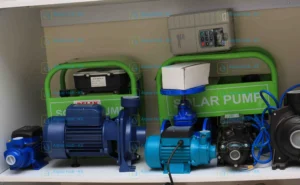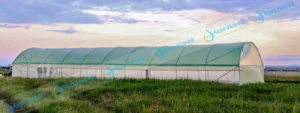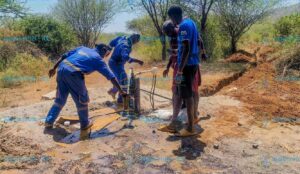Many farmers in remote and arid regions of Kenya find it difficult to produce sufficient food due low rainfall. Solar-powered irrigation farming is proving effective in enhancing sustainable and affordable crop production with less water.
Aqua Hub LTD’s innovative solar-powered irrigation solutions are transforming agriculture in Kenya. We are embracing sustainable irrigation farming practices by installing solar pumps, complete PV modules and drip irrigation kits.
Call 0790719020
Solar-Powered Irrigation System
A solar-powered irrigation system relies completely on sun power to deliver water for irrigating crops. By use of solar pumps that run on sun power collected by PV modules, the water is drawn from the source borehole or river to the system for distribution.
How Much Is a Complete Solar Irrigation System?
Cost of solar Irrigation System ranges from KES 400,000 to KES 900,000 per acre. Cost may be exceed depending on the requirements and other additional components.
Call 0790719020
Complete Solar-Powered Drip Irrigation System
- Solar Panels (PV Modules) – for solar power harnessing.
- Solar Pump – pump for supplying water needed for irrigation.
- Inverter – for DC to AC conversion incase the pump is AC.
- Drip Kits – the accessories for farm irrigation (pipes, driplines, and fittings)
- Water Storage tank – stores water ideal for drip irrigation.
- Mounting Structures – for holding the solar panels.
- Electric Cables – for power supply from panels to inverter. Another cable for carrying power from inverter to pump.
Why Solar Irrigation Is Popular in Kenya
Reliability & Resilience
Solar Pumps enable farmers to grow crops all seasons as they can easily distribute water in dry seasons.
Low fuel expenses
Once installed, solar systems reduce recurring costs like diesel/petrol for pumps, or electricity bills. Diesel and petrol water pumps incur high operational costs compared to solar pumps which use free sun power.
Environmental Benefits
Solar irrigation pumps don’t rely on fossil fuels, thus does not pollute the environment. They are considered clean energy solutions because they are known to operate without need of chemicals or engine oils.
Increased Productivity Crop Yields
with solar irrigation, crops receive the right amount of water consistently making production levels high.
Water Use efficiency
Solar pumps integration with drip irrigation methods ensure water is used effectively. The drip irrigation method distributes water precisely and thus reduces wastage.
Things to Consider when Looking for Solar-powered Irrigation System
Water Source & Pumping Head
- Is your water source shallow (surface, river, water pan) or deep (borehole)?
- The “pumping head” is the vertical distance (plus friction losses in pipes) that the pump must push water.
- Higher head means more powerful pump and more solar panels needed.
- This influences whether you use a surface pump or submersible pump.
Flow Rate Needed
- How much water do your crops need? Based on crop type, plant stage, climatic season.
- Ideal flow rates depend on the farm size, irrigation method and watering frequency.
- Match pump flow rate with your crop needs.
Pressure Requirement
The pressure needed for your irrigation system to work determines the pump and panel setup to use. It also determines if you need a water storage tank setup.
Power Requirement
The energy requirement of the pump will determine solar panel power capacity and number needed.
System Controls & Automation
Solar-powered irrigation kits can also be automated by integrating with moisture sensors to detect dry runs. Pump controllers are also critical to automatically power the pump.
Your choice of pumps, crop water needs and farm size will determine whether you need automation or not.
Maintenance and Support
Consider buying quality solar irrigation accessories from reputable brands known for technical support and warranty. Also consider sourcing from suppliers who have expert technicians for installation and user training.
Solar Panel Sizing & Positioning
Panels need to capture enough sun (Kenya gets good sun in many places, but hours of full sunshine, angle, shading matter).
Panels must be positioned to avoid shade (trees, buildings) and at correct tilt/angle.
Quality of panels matters (efficiency, durability).
Steps for Purchase and Installation of Solar‑Powered Irrigation System
If you are a farmer interested in switching to or getting started with solar irrigation, here’s a practical step‑by‑step approach:
1. Assess Your Water Needs and Source
Measure or estimate how much water your crops need (daily, monthly) during dry and hot seasons.
Identify the source: is it borehole, dam/pan, stream, river, rainwater runoff? Depth or lift required. Reliable year‑round?
2. Choose the required pump, irrigation kits and System Components
Decide flow rate (liters per hour), pumping head, type of pump (surface or submersible).
Choose irrigation method (drip, sprinkler, hose etc.). Drip is often best for water use efficiency, especially for high value crops.
Choose quality panels with warranty, durable pumps, controllers etc.
3. Choose for Reliable Supplier & After‑Sales Support
Aqua Hub LTD is your trusted supplier.
Our solar pumps and accessories are warranted, and we offer maintenance service.
4. Asses the Cost of the System
Inquire about the cost of the solar irrigation kits from the supplier to ensure they match your budget.
5. Setup and Installation
After purchase and delivery of the solar irrigation kits, the next step is installation.
Mount and install the solar panels in a place that receives maximum sunlight. Mounting structures should be installed in an open and protected area then panels mounted.
Proper installation of pump, piping, valves, storage etc.
Ensure proper design so that the system matches your water needs and land layout to minimize losses.
Maintenance Of Solar Irrigation Systems
- Clean the panels regularly to remove dust.
- Inspect wiring, connectors, filters, screen, pump components.
- Monitor performance: water output, pump run time, check for leaks etc.
- Plan for periodic replacement of parts (controllers, wiring, sometimes batteries).
Benefits of Solar Irrigation Systems in Kenya
- Farmers can produce crops year-round: Farmers can grow crops during dry seasons.
- Lower operating costs: Reduces financial risk and dependence on volatile fuel prices.
- Farmers become more resilient to climate shocks: Droughts, erratic rains, even shocks in fuel supply are less crippling.
- Opportunity for smallholders to scale up: Those who were marginal with rain‑fed farming can invest in solar and produce more, get better income.
- Sustainability: Solar powered irrigation is sustainable as it uses renewable and free energy.





